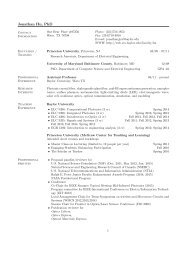Modeling backward-pumped Raman amplifiers - Jonathan Hu ...
Modeling backward-pumped Raman amplifiers - Jonathan Hu ...
Modeling backward-pumped Raman amplifiers - Jonathan Hu ...
Create successful ePaper yourself
Turn your PDF publications into a flip-book with our unique Google optimized e-Paper software.
2084 J. Opt. Soc. Am. B/ Vol. 22, No. 10/ October 2005 <strong>Hu</strong> et al.<br />
must specify the distance-integrated pump power rather<br />
than the boundary value, which is the input power. 5–7<br />
This problem is no longer a two-point boundary-value<br />
problem, and the relaxation algorithm is not flexible<br />
enough to handle it.<br />
In this paper, we describe the alternative approach of<br />
using a shooting algorithm to solve the propagation equations<br />
of <strong>Raman</strong> <strong>amplifiers</strong>. 2,8 Although this method has<br />
been presented previously in the literature, 9–11 we<br />
present extensions and details about the implementation<br />
of the shooting algorithm. We show that when applied appropriately,<br />
the shooting algorithm is as accurate and robust<br />
as the relaxation algorithm while being flexible<br />
enough to satisfy the constraint of fixed gain and, in principle,<br />
other constraints. 7 We show a comparison of two integration<br />
techniques combined with the shooting<br />
algorithm—the improved Euler method and the poweraverage<br />
method 3 —to investigate efficiency and convergence.<br />
We also investigate the use of a Jacobi weight and<br />
a continuation method, in which the pump powers are<br />
gradually increased to the desired values. Using the Jacobi<br />
weight and the continuation method in conjunction<br />
with the shooting algorithm yields a very robust algorithm<br />
for solving the <strong>Raman</strong> amplifier equations. However,<br />
using these extensions typically causes the shooting<br />
algorithm to be slower than the relaxation algorithm,<br />
when they can both be applied to the same problem.<br />
Hence, if one is solving a two-point boundary-value problem,<br />
one should use the relaxation method; whereas if one<br />
requires a different constraint, the shooting method is<br />
preferred.<br />
2. DESIGN ALGORITHM<br />
We describe wave propagation in a <strong>backward</strong>-<strong>pumped</strong>,<br />
multiple-wavelength fiber <strong>Raman</strong> amplifier using a<br />
system of coupled equations that includes the effects of<br />
spontaneous <strong>Raman</strong> scattering and Rayleigh<br />
backscattering. 3,12–16 The pump-to-pump, pump-to-signal,<br />
and signal-to-signal <strong>Raman</strong> interactions are considered in<br />
the coupled equations<br />
± dP m+n<br />
k<br />
dz =− kP k + g jk P j P k ,<br />
1a<br />
j=1<br />
where n is the number of pump waves and m is the number<br />
of signal waves. The values P k , k , and k describe, respectively,<br />
the power, frequency, and attenuation coefficient<br />
for the kth wave, where k=1,2,…,m+n. The<br />
quantities P ASE,k , P SRB,k , and P DRB,k are the powers corresponding<br />
to amplified spontaneous emission (ASE) noise,<br />
single Rayleigh backscattering (SRB), and double<br />
Rayleigh backscattering (DRB), respectively. The gain coefficient<br />
g jk describes the power transferred by stimulated<br />
<strong>Raman</strong> scattering between the jth and kth waves and<br />
is given by g jk =1/2A eff g j j − k for j k and g jk =<br />
−1/2A eff k / j g k k − j for j k , where g i is the<br />
<strong>Raman</strong> gain spectrum measured with respect to the pump<br />
frequency i , shown in Fig. 1 for silica fiber at the pump<br />
wavelength 0 =1 m, and A eff is the fiber effective area.<br />
The temperature-dependent term contributing to ASE<br />
noise is given by F jk =N phon +1 for j k , F jk =−N phon for<br />
j k , where N phon =exph j − k /k B T−1 −1 . Here, the<br />
parameters K, T, k B , and h are the Rayleigh backscattering<br />
coefficient, the temperature of the system, Boltzmann’s<br />
constant, and Planck’s constant, respectively. For<br />
a fiber span of length L, the boundary conditions are defined<br />
at z=0 for the signal waves P k 0=P k0 k<br />
=1,2,…,m, and at z=L for the <strong>backward</strong>-propagating<br />
pump waves P k L=P k0 k=m+1,m+2,…,m+n. In Eqs.<br />
(1a) and (1b), one uses the + sign for forward-propagating<br />
waves and the − sign for <strong>backward</strong>-propagating waves.<br />
Equations (1) are valid under the assumption that the<br />
gain in the <strong>Raman</strong> amplifier is due only to pump-to-signal<br />
and signal-to-signal <strong>Raman</strong> scattering. Therefore we neglect<br />
the <strong>Raman</strong> interaction of the ASE, SRB, and DRB<br />
with the pumps and signals, as this interaction is very<br />
small. Also, polarization effects have been neglected in<br />
Eqs. (1).<br />
Previous publications that describe the numerical<br />
implementation of the <strong>backward</strong>-<strong>pumped</strong> <strong>Raman</strong> ampli-<br />
± dP m+n<br />
ASE,k<br />
=− k P ASE,k +<br />
dz g jk P j P ASE,k + h k F jk ,<br />
j=1<br />
1b<br />
− dP m+n<br />
SRB,k<br />
=− k P SRB,k +<br />
dz g jk P j P SRB,k + KP k ,<br />
j=1<br />
1c<br />
dP DRB,k<br />
dz<br />
m+n<br />
=− k P DRB,k + g jk P j P DRB,k + KP SRB,k ,<br />
j=1<br />
1d<br />
Fig. 1. (a) <strong>Raman</strong> gain spectrum g R of a typical silica fiber<br />
at the pump wavelength 0 =1 m. (b) Loss profile for a typical<br />
silica fiber.



